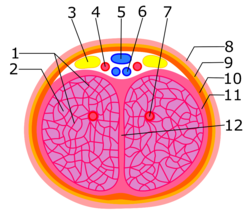In sex organs
This section is missing information about process of stimulation and erection of the clitoris and vestibular bulbs.(October 2023) |


Erectile tissue exists in external genitals such as the corpora cavernosa of the penis and their homologs in the clitoris, also called the corpora cavernosa. [2] During penile or clitoral erection, the corpora cavernosa will become engorged with arterial blood, a process called tumescence . [3] This may result from any of various physiological stimuli which can be internal or external. This process of stimulation, due to internal or external stimuli, is also known as sexual arousal. The corpus spongiosum is a single tubular structure located just below the corpora cavernosa in males. This may also become slightly engorged with blood, but less so than the corpora cavernosa.